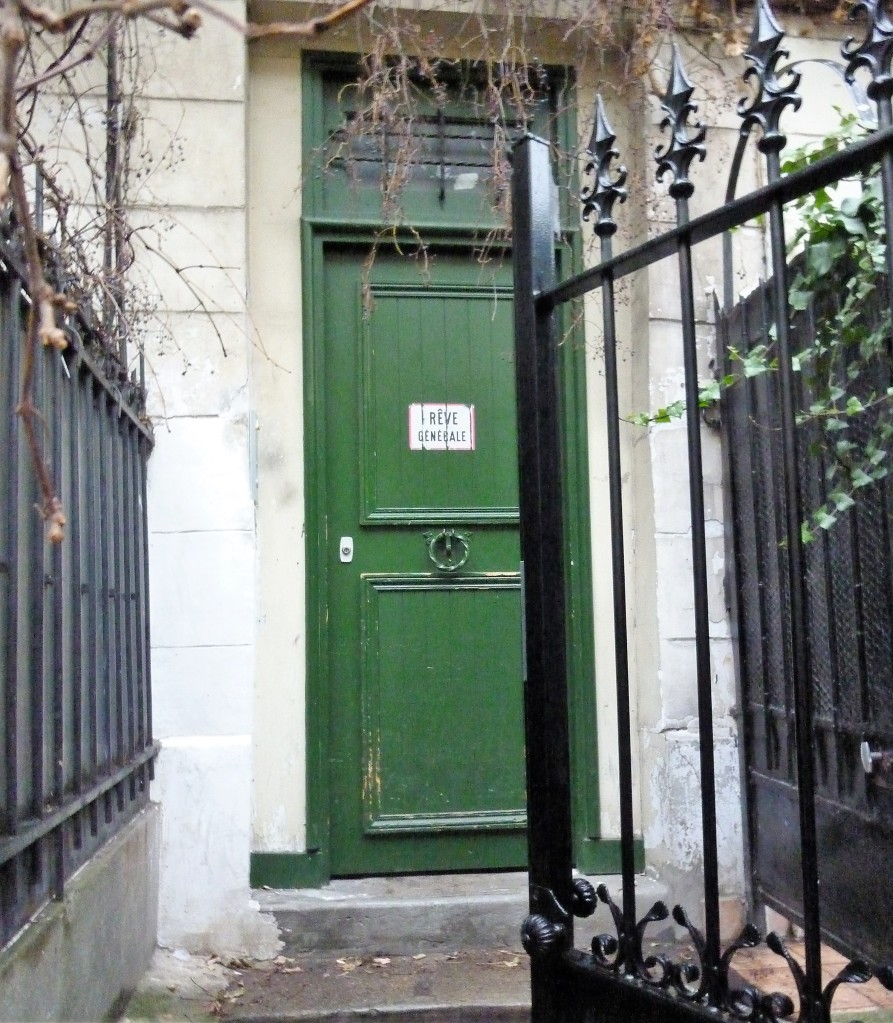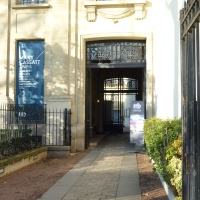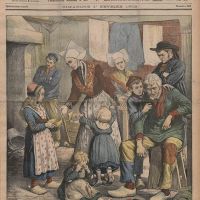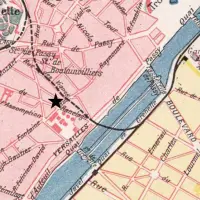I once bought a book called How to Read Paris, which was really just a book about the city’s architecture. If I were to write a book with that title, I would talk about the words on the city’s walls. The streets are full of words, some put there by officials, some added by residents.
During the holidays, I went through photographs we have taken over the years, and began to classify the various types of writing.
There are, of course, street names, usually in blue and white enamel, but all kinds of other versions exist, often side-by-side with the standardized version.

In a few places, people have taken it upon themselves to suggest new names for streets. One, made to look like the official version, places the street in the mythical “21st arrondissement.” “La fa mi” looks like musical notes, but may be a pun on “la famille.”

Another suggests that a street in the 20th arrondissement would be better named for the rights of children.
A street on the Left Bank was unofficially named for the designer Eileen Gray.

Another commemorates a woman who was killed in 2019 by her ex-partner. (That year, we noticed many signs about the number of women killed by partners and ex-partners, and there were demonstrations in the streets about the appalling number of deaths in France and elsewhere.)

The names of architects often appear on the sides of buildings, usually at the level of the floor just above the street. Usually, they are chiselled in ordinary letters, but two Art Nouveau architects stand out. Hector Guimard is in a distinctive form, and Frantz Jourdain, the Belgian architect who designed La Samaritaine, seems to have signed at least one building with a personal flourish.

Buildings also used to advertise the availability of water and gas.

Plaques throughout the city commemorate the famous and the not-so-famous. The standard modern version is that of the metal “pelle” or oar shape designed by Philippe Starck…

…but all kinds of other versions exist as well. Here is one commemorating an architect who conferred nobility on reinforced concrete as a building material, an achievement not often celebrated.

And then there are the homemade versions, both poetic…

(Here lived a woman who felt herself infinitesimally small in looking at the stars)
…and prosaic.

(Here lived a woman who cooked 77,603 meals in her lifetime.) Both plaques are by the same anonymous author/artist.
Ghost signs indicate former businesses or advertisements. There are whole websites and Instagram accounts devoted to ghost signs, some of which are very attractive. We’ve photographed a few that might not make the cut. The only words we can make out on this one are “insectes nuisibles” (harmful insects), so we think it refers to an extermination company.

This one, on an adjoining wall, includes a drawing of an insect. The word “punaise” (bug) is just visible, along with a large letter M.

This truncated ad for a furniture shop is clearer.

And the sign for the French Neon Company is also quite legible.

Here is one that layers one ghost sign on another. I can make out “Dubonnet” as well as a sign for Rochefort wallpaper.

One very small ghost sign in the courtyard of a building in the Marais once directed people to a registry.

Officialdom posts rules and regulations on walls. Don’t leave your garbage here.

Don’t post bills on the wall (some wag has assented with a bill “D’accord” – okay).

Many of the Post No Bills signs include the date of the relevant law, for some reason. Sounds more official, I suppose.

A much more recent one: No smoking on the sidewalk.

No fishing (at the entrance to the Port de Plaisance). A wordless version.

No beating rugs under the bridge (at the same location). Who would have thought that was a problem?

Unofficial signs that mimic the official versions in enamel warn of psychotic cats or amiable dogs.

No parking, with, inevitably, a car in front. One assumes that the car owner is discouraging other people from parking there.

And then there is graffiti. Everywhere. It disappears when a building is cleaned or repainted. The Fondation Cartier in 2009 mounted an exhibition devoted to this controversial art form, called “Born in the Streets.” Some is witty or whimsical, some is just…tagging, often in hard-to-get-at spaces.

Some of it is incomprehensible. Here’s one, created with a stencil, just above a sign commemorating the flood of 1910. Challenge to readers: can you figure it out?

Here’s one we can read, but we’re not sure what it means.

Some are cadavers; others picnic. Erm, okay.
We have a few favourites. We have already mentioned “Libérez les sardines” in a previous blog. This one, on a door rather than a wall, is a pun on Grève Générale (general strike), but evokes a general dream.

Another, scribbled underneath a window, riffs on the description of the daily grind in Paris (“Métro – boulot – dodo” or Commute – work – sleep). The writer is clearly finding it all too much (mais trop). Underneath is a reference to “Nuit debout,” the protests against labour reforms that began in 2016 and centred on the Place de la République. But this writer wants a “Nuit dessous” – a night underneath (the covers perhaps?).

A quotation from Confucius is pasted on the entrance to an underground parking lot. When words lose their meaning, people lose their liberty. True.

This one notes that craziness is the price we pay for liberty. Also true. I guess.

But my all-time favourite, created with a stencil, is in English. It appears beside the door to the Association Valentin Haüy, an organization that offers training and other assistance to people who are blind. It reminds me a of a song by Gerry Goffin and Carole King called “Sometime in the Morning” (which those of a certain generation may recall).

Indeed, Paris is a city that can be read. The words change over time, as some vanish and new ones appear. Which is why one needs to go back again and again. As we will…when we can. Meanwhile, we wish all our readers the very best for 2022.
Text by Philippa Campsie, photographs by Norman Ball and Philippa Campsie.






















I loved all of the photos and comments, but especially the one of Confucius. I did share that one with others. Thank you!
Sur la porte cochère du 12 rue Beautreillis, le graffitto d’un piéton de Paris au XVIIIe s. Louis Sébastien Mercier ?
>
Thank you!
I was able to decipher a little bit more from the first ghost post. I am not sure about DES, tous, En and 15:
DERATISATION DES
Pour la destruction de tous
Rongeurs et insectes nuisibles
En Vente
15 Rue du Louvre
I just discovered that NoonieNoonieNoonie has an instagram account.
There was recently, on France Culture, an interesting video on women taking the streets with powerful posters: https://www.franceculture.fr/histoire/dolympe-de-gouges-aux-colleuses-la-revolution-de-laffichage-feministe
Happy New Year!
Love this, so fascinating. I’m glad you go around photographing signs!
Wonderful